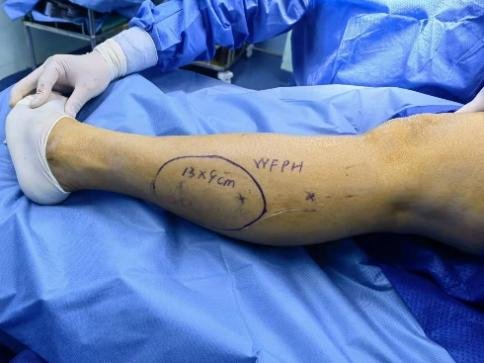Amazing! The second area of the Department of Traumatology and Orthopedics of Weifang People’s Hospital used “super microsurgery technology” to complete the repair of the patient’s hand back defect.
Master Liu, 52, suffered severe damage to the skin and soft tissue on the back of his right hand due to thermal pressure injury. The area of the skin and soft tissue defect was about 12cm×8cm, and the tendon and bone were exposed. The other hospital suggested that he underwent abdominal pedicled skin flap. The abdominal pedicle skin flap needs to be “sewed with the hand on the belly” first. After the flap survives three weeks later, the pedicle of the skin flap is cut off to treat the patient’s hand defect.
Master Liu went to Weifang City People’s Hospital for treatment and said firmly: “I really can’t accept hand sewing on my belly!”. He hopes to focus on comfort to solve the problem and restore the original appearance of the back of the hand.
The patient had skin and soft tissue defects on the back of the hand. According to previous technical experience, a pedicled abdominal flap was required to cover the wound surface. After survival, a second operation to cut off the pedicle and later plastic surgery was performed. If the peroneal artery perforator flap is selected to repair this area, the requirements for wound coverage and aesthetics can be achieved at one time, and the damage to the donor site is less. However, this technology also imposes almost harsh technical requirements on doctors. Doctors must master super microsurgery technology, probe and dissect and track extremely thin perforating vessels, and anastomose and recanalize the blood vessels to ensure the success of the operation. .
After discussion in the department, combined with the characteristics of the hand tissue and the requirements of the patients, the second area of trauma orthopedics adopted the latest perforator flap repair technology, and chose to take the free peroneal artery perforator flap of the contralateral calf. Flap reshaping, removing part of the adipose tissue, leaving only the perforating vessels. The first-stage flap survived smoothly, with a high degree of fit with the skin and soft tissue of the recipient area on the back of the hand, high aesthetics, and little damage to the donor area. The patient is very satisfied with the postoperative appearance, and he is even happier that the affected limb is completely free, and there is no need to “sewn on the belly”!

Perforator flap is a hot research field of flap surgery in recent years, and it is also the frontier direction of repair and reconstruction surgery. Compared with traditional free flaps, free perforator flaps have thinner vessels and require higher microsurgical techniques. Super microsurgery uses perforator vessels to align perforator vessels without damaging the main vessels. It has the advantages of “good repair and reconstruction in the recipient area and less damage in the donor area”, which brings good news to the majority of patients.